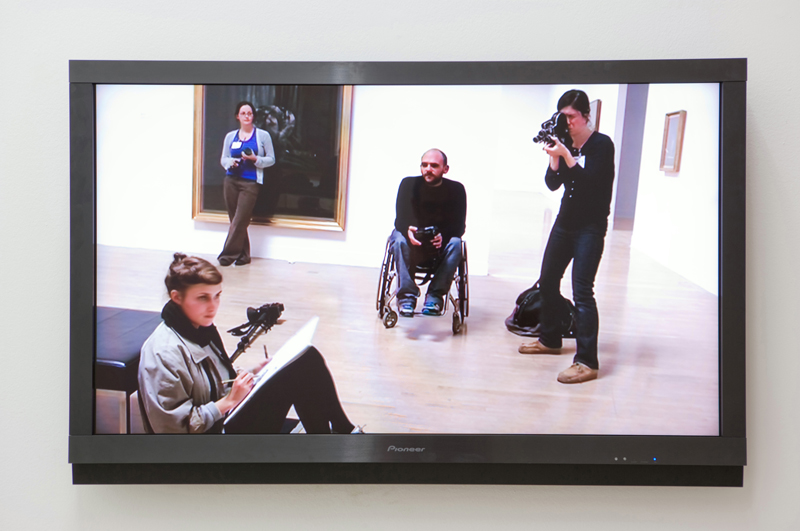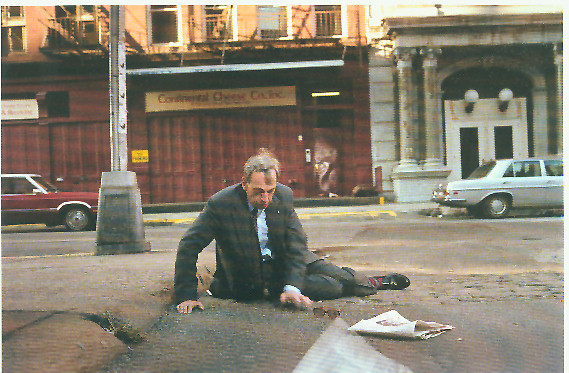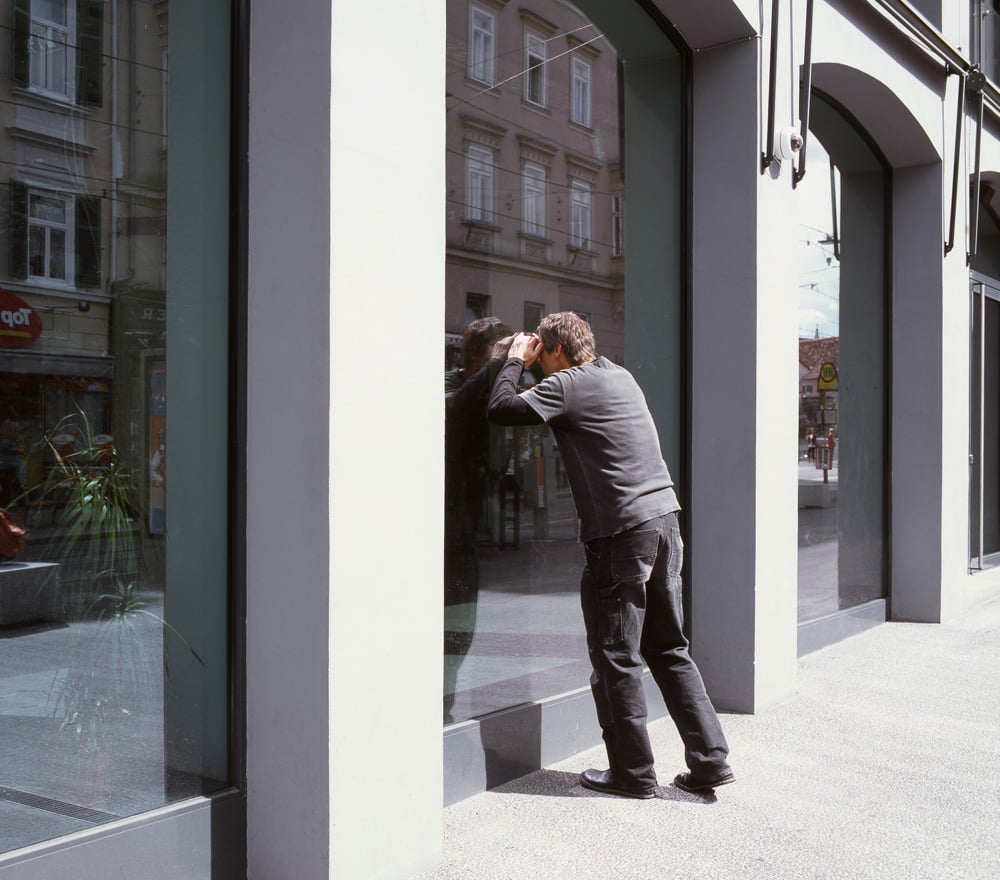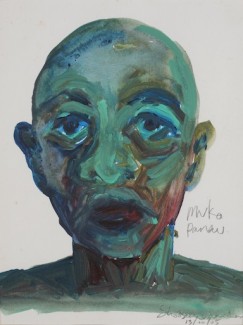
© » KADIST
Mary Helena Clark
The Dragon is the Frame by Mary Helena Clark is an elegy that is somewhat paradoxically organized as a film noir or murder mystery, one that pays direct homage to Hitchcock’s Vertigo . But the parts don’t fit, and it is only in the eventual recognition of this faux raccord that Clark’s higher purpose becomes apparent. As we hear Bernard Herrmann’s score, we see the Golden Gate Bridge, Mission Dolores, and other Vertigo locations in the present day.

© » KADIST
Connie Zheng
The Lonely Age by Connie Zheng is the first chapter in a trilogy of short experimental films about the complex temporalities of navigating ongoing environmental crises, as seen through the lens of seeds real and imagined. The film is set in a highly toxic and ecologically ravaged near future, in which people begin to hear rumors of seeds that have washed up on the shores of California after escaping from a factory in China. The seeds are rumored to possess curative properties, but they are also said to be sentient.

© » KADIST
Sofía Córdova
Sofía Córdova’s film dawn_chorusiii: the fruit they don’t have here / coro_del_albaiii: la fruta que no tienen aquí weaves together six California migration stories that resist dominant social narratives that flatten the experience of migrants. Though each woman’s story is based on interviews conducted by Córdova through voice memos or phone calls, the women’s lines in the film are reinterpreted and altered by the artist as a gesture that affords them opacity and relative anonymity. The opening sequence begins with four of the women looking into the camera, reciting a poem about the transition from winter to spring in Spanish and Mandarin: the birds dropping seeds they brought from afar, planting saplings that grow into trees bearing the fruit they don’t have in their new homes.

© » KADIST
Taiyo Kimura
Haunted by You documents Taiyo Kimura’s struggle to use a record player, satirizing the normal actions of everyday life in order to question the meanings that underlie ordinary modes of living. The performance narrative unfolds upon the circular movements of the turntable. A chicken’s leg replaces the turntable’s arm.

© » KADIST
Gauri Gill
Acts of Appearance is an ongoing series by Gauri Gill consisting of lush, large-scale color portraits of the residents of a village in Maharashtra, in Western India, which is known for making Adivasi masks. Adivasi people are part of the tribal groups population of South Asia. Instead of requesting the likenesses of gods and demons, Gill asked the residents—including the master mask-makers Subhas and Bhagavan Dharam Kadu, their families, and fellow volunteers—to make masks that portray their own lives.

© » KADIST
Sung Hwan Kim
An early work in Sung Hwang Kim’s career, the video Summer Days in Keijo—written in 1937 is a fictional documentary, the film is based on a non-fiction travelogue, In Korean Wilds and Villages , written by Swedish zoologist Sten Bergman, who lived in Korea from 1935 to 1937. In Kim’s film, a Dutch female protagonist traces Bergman’s path in the present-day Seoul (Keijo was the Japanese name for Gyeongseong, currently Seoul). The protagonist navigates through spaces that have been rebuilt since the 1950s onwards, and the scenes are narrated by a voice-over based on Bergman’s written description of the modern city in 1937.

© » KADIST
Pablo Pijnappel
In Felicitas, we follow the converging routes of three characters: Felicitas, Michael and Andrew (the artist’s father-in-law who also features elsewhere). Felicitas is thedaughter of a German industrialist who immigrated to Rio after the Second World War. She is the one visible with a toucan in several images.

© » KADIST
James "Yaya" Hough
Drawing & Print (Drawing & Print)
This untitled ink and pencil drawing by James “Yaya” Hough is made on what the artist calls “institutional paper”, or the state-issued forms that monitor the daily activities of prisoners, of which, each detainee is generally required to fill out in triplicate. The form used for this drawing details a weekly menu for the prisoners. Hough’s drawing depicts three grimacing figures, riding atop the back of a larger, female figure on all fours.

© » KADIST
Pooja Gurung and Bibhusan Basnet
DADYAA: The Woodpeckers of Rotha by Pooja Gurung and Bibhusan Basnet illuminates a unique and seldom seen international perspective on indigenous cultures and contemporary social issues in the Nepali context. A small masterpiece, the work engages with one of the most pressing social issues in Nepal, mass migration and the dissolving of social fabric in rural areas. The story begins with an old couple, Atimaley and Devi, who live in a village in Jumla, in the highlands of Western Nepal.

© » KADIST
Alejandro Almanza Pereda
This still life falls apart, or rather floats apart as the composition is proved unstable and constantly morphing. An impossible attempt at achieving a fixed state, some objects remain buoyant and some objects sink, constantly tilting the overall scale and arrangement. Properties of weight, mass and shape have their own will but a hand appears in the scene, pushing back on these mysterious forces.

© » KADIST
Bady Dalloul
Bady Dalloul’s Scrapbook is a 48 minute video beginning from his birth, tracing major global events of the 20 th century, including the beginning and current Occupation and colonization of Palestine, the atomic bombings of Hiroshima and Nagasaki, assassination of family members and the Syrian diaspora. A voice over follows these moments as the camera traces over the collage that includes text; photos; postcards; origami birds; and inserted videos of world leaders. The film is a letter to the viewer, imploring the witnessing of what we assume, but cannot know, to be the artist speaking.

© » KADIST
James "Yaya" Hough
Drawing & Print (Drawing & Print)
This untitled ink and pencil drawing by James “Yaya” Hough is made on what the artist calls “institutional paper”, or the state-issued forms that monitor the daily activities of prisoners, of which, each detainee is generally required to fill out in triplicate. The form used for this drawing is a request for medical attention. This work illustrates an assembly-line of severed bodies being pumped full of feet and other body parts.

© » KADIST
Tao Hui
For 7 Materials , Tao Hui films seven scenes selected from the countless scenarios in his notebooks, including a group of ethnic minority girls in a spoil pit in the rain, a reporter interviewing a corpse, and a deity sailing on the river. Due to the lack of internal logical order, these one-minute video “materials” are not played in a fixed sequence but randomly. For Tao Hui, to film his diary is to adorn and embellish his memories before evoking and reviving their spirits.

© » KADIST
Sarah Navqi
A “mata ni pachedi” is a piece of painted textile that depicts narrative images of goddesses. Traditionally, the images would be painted onto a piece of cloth found in the temple. Also known as the “kalamkari” (a hand-painted or block-printed cotton textile), “mata ni pachedi” literally translates to “behind the mother goddess”.

© » KADIST
Prajakta Potnis
he woke up with seeds in his lungs by Prajakta Potnis is a set of x-ray films presented through backlit light boxes of found objects constructed to evoke the body or organs that turns the host into a foreign element. The title of the work is inspired by a story the artist came across during her research, according to which a man had swallowed seeds that started to grow inside his organs. In the work, interior scapes of the body appear as radioactive rays pass through various materials.

© » KADIST
Ryan Gander
The work consists of a work inside a work. The spectator is presented with a commissioned documentary on a flat-screen Tv on the subject of the production of the making of an artwork that doesn’t exist entitled The magic and the meaning (2008). The imaginary film, The magic and the meaning , is described only within the documentary, which follows parts of the making of the film, extracts from interviews with the writer and film maker Dan Fox and the artist and maker of the work Ryan Gander; as well as showing short slow-motion sections of the film that does not exist.

© » KADIST
Roman Ondak
Drawing & Print (Drawing & Print)
As the caption purposely admits, these drawings were made by friends of Ondák’s at home in Slovakia asked to interpret places he has journeyed to. The description of the blond artist wearing the same outfit and bag in places of transit like airports, stations or streets are faithful in straightforward (verging on naïve) styles. His own skill as artist is displaced and delegated to others with no particular gift in draftsmanship.

© » KADIST
Martha Colburn
Martha Colburn’s film, Western Wild … or How I Found Wanderlust and Met Old Shatterhand , about the famed German author Karl May weaves together a mixture of stop motion animation, travelogue and biography that generates a kind of sensory wanderlust. Conflating past and present, the film investigates issues of identity and representation, as well as violence and war. The artist considers imagination as an invitation to dream, in order to disrupt the limitations of the everyday context and widen her viewers’ horizons.

© » KADIST
Omer Fast
This work is based on a temporal loop in which the stories of several duets coexist and interfere with each other. The narrative articulates itself around four key moments or four neighboring apartments that the viewer discovers progressively: an air stewardess having an argument with her unemployed husband, and old lady telling old stories that no longer interest her caregiver, a black woman who is accused of stealing jewelry just when a newcomer, of Arab origin, moves into the apartment block. The narration itself is based on a void or non-event, however its dialogues refer to subjects such as terrorism or iimmigration.

© » KADIST
Claudia Joskowicz
Los rastreadores is a two-channel video by Claudia Joskowicz narrating the story of a fictitious drug lord, Ernesto Suarez, whose character is based on the well-known Bolivian drug dealer, Roberto Suárez. In the video, Suarez returns home from prison and survives a massacre that takes place at his home in Bolivia. Told in four chapters, the story is inspired by John Ford’s American Western classic film The Searchers (1956), this work similarly focuses on the politicized atmosphere of Bolivian history, searching for cues of race and alienation.
James "Yaya" Hough
Working in ballpoint pen, pencil, and watercolor, often on the backs of bureaucratic prison forms, James “Yaya” Hough’s work conveys the burdens of incarcerated life, revealing not only the brutal reach of the carceral system, but laying bare its affects...
Gauri Gill
Gauri Gill is interested in the social contract of photography...
Bady Dalloul
Bady Dalloul cunningly employs collage across various media: texts, drawings, video, and objects to produce powerful works commenting on the past and the present...
Ryan Gander
- location: Chester, United Kingdom
- year born: 1976
- gender: male
- nationality: British
Connie Zheng
Connie Zheng is an artist, writer, filmmaker, and field recordist...
Philip-Lorca diCorcia
The works of Philip-Lorca diCorcia oscillate between two possible definitions of photography – from a recording system in the tradition of documentary and a system of representation in the tradition of fiction...
Martha Colburn
Martha Colburn is known for hand-made animations, which she creates through puppetry, collage, and paint-on-glass techniques...
Claudia Joskowicz
Claudia Joskowicz is a video and installation artist working at the intersection of landscape, history, and memory...
Taiyo Kimura
Taiyo Kimura works with sculpture, video, and installation and uses everyday objects, humor, and music to questions the meaning of ordinary life...
Mary Helena Clark
Mary Helena Clark is an artist working in film, video, and installation...
Alejandro Almanza Pereda
Alejandro Almanza Pereda has a heightened understanding of the essence of objects...
Sung Hwan Kim
In his practice, Sung Hwan Kim assumes the role of director, editor, performer, composer, narrator, and poet...
Tao Hui
Tao Hui indeed believes that fairy tales can ease people’s intensive mind...
Pablo Pijnappel
Pablo Pijnappel’s work is foremost highly constructed...
Roman Ondak
- location: Zilina, Slovenská Republika
- year born: 1966
- gender: male
- nationality: Slovakian
Pooja Gurung and Bibhusan Basnet
Pooja Gurung and Bibhusan Basnet have a joint practice that merges film and visual art...
Sarah Navqi
Sarah Naqvi works with art-focused activism and material realities...
Prajakta Potnis
Prajakta Potnis’s work dwells between the intimate world of an individual and the world outside, which is separated sometimes only by a wall...
Omer Fast
- location: Yerushalayim, Yisra'el
- year born: 1972
- gender: male
- nationality: Israeli
-
-
2000-2009
Roman Ondak
Drawing & Print
2003(Drawing & Print) As the caption purposely admits, these drawings were made by friends of Ondák’s at home in Slovakia asked to interpret places he has journeyed to...
Pablo Pijnappel
2005In Felicitas, we follow the converging routes of three characters: Felicitas, Michael and Andrew (the artist’s father-in-law who also features elsewhere)...
Sung Hwan Kim
2007An early work in Sung Hwang Kim’s career, the video Summer Days in Keijo—written in 1937 is a fictional documentary, the film is based on a non-fiction travelogue, In Korean Wilds and Villages , written by Swedish zoologist Sten Bergman, who lived in Korea from 1935 to 1937...
-
2010-2019
Taiyo Kimura
2010Haunted by You documents Taiyo Kimura’s struggle to use a record player, satirizing the normal actions of everyday life in order to question the meanings that underlie ordinary modes of living...
Mary Helena Clark
2014The Dragon is the Frame by Mary Helena Clark is an elegy that is somewhat paradoxically organized as a film noir or murder mystery, one that pays direct homage to Hitchcock’s Vertigo ...
Claudia Joskowicz
2014Los rastreadores is a two-channel video by Claudia Joskowicz narrating the story of a fictitious drug lord, Ernesto Suarez, whose character is based on the well-known Bolivian drug dealer, Roberto Suárez...
Gauri Gill
2015Acts of Appearance is an ongoing series by Gauri Gill consisting of lush, large-scale color portraits of the residents of a village in Maharashtra, in Western India, which is known for making Adivasi masks...
Alejandro Almanza Pereda
2015This still life falls apart, or rather floats apart as the composition is proved unstable and constantly morphing...
Bady Dalloul
2015Bady Dalloul’s Scrapbook is a 48 minute video beginning from his birth, tracing major global events of the 20 th century, including the beginning and current Occupation and colonization of Palestine, the atomic bombings of Hiroshima and Nagasaki, assassination of family members and the Syrian diaspora...
James "Yaya" Hough
Drawing & Print
2016(Drawing & Print) This untitled ink and pencil drawing by James “Yaya” Hough is made on what the artist calls “institutional paper”, or the state-issued forms that monitor the daily activities of prisoners, of which, each detainee is generally required to fill out in triplicate...
James "Yaya" Hough
Drawing & Print
2016(Drawing & Print) This untitled ink and pencil drawing by James “Yaya” Hough is made on what the artist calls “institutional paper”, or the state-issued forms that monitor the daily activities of prisoners, of which, each detainee is generally required to fill out in triplicate...
Martha Colburn
2017Martha Colburn’s film, Western Wild … or How I Found Wanderlust and Met Old Shatterhand , about the famed German author Karl May weaves together a mixture of stop motion animation, travelogue and biography that generates a kind of sensory wanderlust...
Pooja Gurung and Bibhusan Basnet
2018DADYAA: The Woodpeckers of Rotha by Pooja Gurung and Bibhusan Basnet illuminates a unique and seldom seen international perspective on indigenous cultures and contemporary social issues in the Nepali context...
Connie Zheng
2019The Lonely Age by Connie Zheng is the first chapter in a trilogy of short experimental films about the complex temporalities of navigating ongoing environmental crises, as seen through the lens of seeds real and imagined...
Sarah Navqi
2019A “mata ni pachedi” is a piece of painted textile that depicts narrative images of goddesses...
-
2020-2029
Prajakta Potnis
2020he woke up with seeds in his lungs by Prajakta Potnis is a set of x-ray films presented through backlit light boxes of found objects constructed to evoke the body or organs that turns the host into a foreign element...
Sofía Córdova
2021Sofía Córdova’s film dawn_chorusiii: the fruit they don’t have here / coro_del_albaiii: la fruta que no tienen aquí weaves together six California migration stories that resist dominant social narratives that flatten the experience of migrants...










